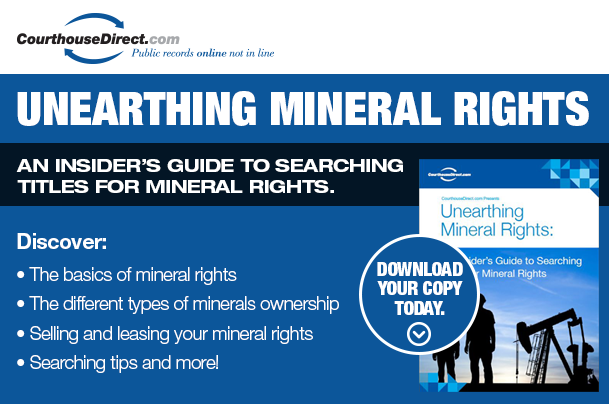 Searching for mineral rights can be a challenging task, but a property owner successfully searching out the details of who owns the mineral rights to his or her land can be a rewarding experience, full of interesting turns. This guide will provide an overview of the process and get you started in the right direction for discovering who owns what is under your land.
Searching for mineral rights can be a challenging task, but a property owner successfully searching out the details of who owns the mineral rights to his or her land can be a rewarding experience, full of interesting turns. This guide will provide an overview of the process and get you started in the right direction for discovering who owns what is under your land.
Start with What You Have
The first place to start is with your own property deed. The property deed will give you important information needed to begin your search as well as providing a familiar example of the information you will be looking for in your search.
Look for this key information on the property deed:
- Type of deed. This may say something like real estate deed, title deed, quitclaim deed, or other similar terms. This tells you what type of document this is, but be aware that this does not always tell the whole story. The information in the deed’s description ultimately determines what type of deed this is.
- Seller information. Often called the “grantor”, this gives you information about the previous owner of the property, including their name and address at the time of the sale. In your search you will need to form a chain from your ownership to the previous owner all the way back till you find the owner of the mineral rights. The grantor section gives you the first link in that chain.
- Buyer’s information. The buyer is usually referred to as the “grantee”. In the case of your deed, this is your name and address at the time of the sale. As you follow the records up the chain you will be looking for the grantor on your deed listed as the grantee in the previous sale.
- Transfer details. This may be termed conveyance or under other terms as well. This describes the rights being transferred to the buyer. Usually this says, in effect, that the grantor transfers all rights to the property to the grantee and their successors or heirs.This is a key section that is often broken out from the conveyance section. This lists any exceptions to the rights being transferred. Ordinarily this may contain language excluding any easements on the property or existing liens. If mineral rights are being retained by the grantor, that detail may be found in this section.
- Property description. This is the legal description of the property. In states using the Public Land Survey System (PLSS) this will include a description of the section, township and range where the property is located. It may help to familiarize yourself with how to read PLSS descriptions. Many states, including Texas, use the old British metes and bounds system instead, which will list the block and lot number and the name of the subdivision the property is located in.
Once you are familiar with your own deed, you have a good place to start your search for the mineral rights to the property.
Where to Conduct the Search
Records for property transfers are kept at the county recorders office of the county where the property is located. The county recorder is usually in the county courthouse or nearby. It is likely that the search for the mineral rights owner will stretch back over many property deed transfers, going back a century or more. Even those experienced in this field may take weeks or months to thoroughly search out the mineral rights owners.
You do have some options for how to proceed, however:
- Have a title company complete the search. Hiring a title company, or abstract company, to perform the search for you requires the least work on your part. They will have the experience to complete your search in the least amount of time and a good title company will also give you the assurance that the search was thorough and complete. This option is the most expensive, but if your search is particularly complex or if you do not feel comfortable completing the search yourself, this is a good way to get the answers you need.
- Have a title company assist your search. Contributing some of the work yourself can lessen the expense of the mineral rights search while taking advantage of the expertise of a good title company. Ask the title company for a take-off specifying that you are only interested in documents related to the mineral rights to your property. The take-off will provide you with the list of books and pages where the deeds and conveyances for your property are located. A take-off is still a significant cost, but will greatly reduce the difficulty of your search.
- Use an online records search. Rather than physically going to the courthouse to search through the stacks of books and records, you may opt to search using an online records search company. The largest online repository, com, digitizes records from hundreds of counties and makes their records available for a modest fee. Whether you are doing the search alone or getting a take-off from a title company, this option can save you time and is more convenient than searching at the county recorder’s office.
- Travel to the county recorder’s office. The final option is to travel to the county recorder’s office of the property in question and conduct your search in person. Most offices publish their hours of operation online as well as any requirements they have for those conducting searches. A schedule of fees is usually also published on their website, or can be obtained in person while you search.
Conducting the Search
The county recorder stores property information in books of deeds. If you have a take-off you can search specifically for the book and page you need to find the information about the property. Otherwise you will need to start with the legal property description and other information from your deed. If you don’t have a copy of your deed, begin with searching for your own property title and working backwards from there.
Construct a chain of ownership beginning with yourself and working backwards until you find who last transferred the mineral rights. Be aware that the mineral rights may be owned by more than one individual or company. It is also possible that a royalty deed was created that does not transfer ownership of the mineral rights, but grants the royalty owner a share of the proceeds from any minerals produced by the land.
Occasionally, you may find gaps in the chain of ownership. This may occur if a bank claimed a property through a lapsed mortgage or if the property ownership was transferred through a divorce decree rather than a standard sale. It also happens that from time to time a deed is misfiled or a faulty description leads to the deed being filed in the wrong location.
Establishing the owner of mineral rights may be challenging, but the journey can be a rewarding and interesting challenge if you are determined to see it through.























